
Lasius is a genus of formicine ants. The type species for this genus is the black garden ant, Lasius niger. Other major members, which live in drier heathland, are the cornfield ant, L. neoniger, and L. alienus. Other species include the temporary social parasites of the L. mixtus group and the hyper-social parasite Lasius fuliginosus. Lasius flavus is also a commonly seen species, building grassy hillocks in undisturbed pasture. In the Alps, these mounds - always aligned east to catch the first rays of the rising sun - have been traditionally used by goatherds as natural compasses. Species in the subgenus Acanthomyops, in particular L. interjectus and L. claviger, are commonly known as citronella ants due to their citronella-like smell.

The black garden ant, also known as the common black ant, is a formicine ant, the type species of the subgenus Lasius, which is found across Europe and in some parts of North America, South America, Asia and Australasia. The European species was split into two species; L. niger, which are found in open areas; and L. platythorax, which is found in forest habitats. It is monogynous, meaning colonies contain a single queen.

Agave victoriae-reginae, the Queen Victoria agave or royal agave, is a small species of succulent flowering perennial plant, noted for its streaks of white on sculptured geometrical leaves, and popular as an ornamental.

The northern olingo, also known as the bushy-tailed olingo or as simply the olingo, is a tree-dwelling member of the family Procyonidae, which also includes raccoons. It was the first species of olingo to be described, and while it is considered by some authors to be the only genuine olingo species, a recent review of the genus Bassaricyon has shown that there are a total of four olingo species, although two of the former species should now be considered as a part of this species. Its scientific name honors William More Gabb, who collected the first specimen. It is native to Central America.
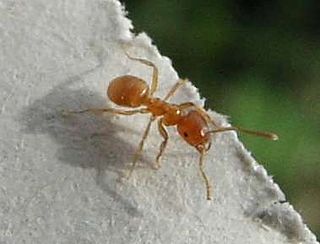
The yellow meadow ant, also known as the yellow hill ant, is a species of ant occurring in Europe, Asia, and North Africa. Populations in North America are now considered a different, related species, Lasius brevicornis.

A species that is extinct in the wild (EW) is one that has been categorized by the International Union for Conservation of Nature as known only by living members kept in captivity or as a naturalized population outside its historic range due to massive habitat loss.
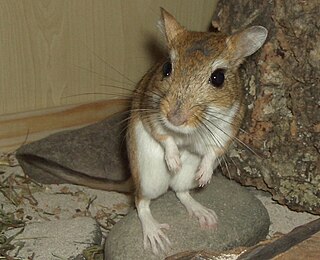
The Persian jird is a species of rodent in the family Muridae found in Afghanistan, Armenia, Azerbaijan, Iran, Iraq, Pakistan, Turkey, and Turkmenistan.
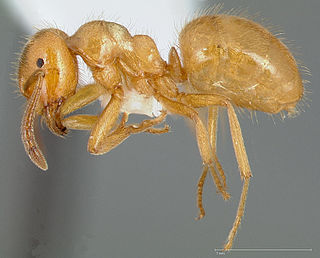
Lasius latipes is a species of ant in the genus Lasius. It is native to the United States.
Lasius murphyi is a species of ant in the genus Lasius. It is endemic to the United States and Canada.

Lasius umbratus, colloquially known as the yellow shadow ant and yellow lawn ant, is a palearctic species of parasitic ant distributed across Eurasia and the Maghreb region of Africa. It was once thought that this species occurred in North America as well, but comparative genomic studies indicate the Afro-Eurasian and American populations are discrete and not closely related enough to represent a single species. The North American populations are now treated as a different species, Lasius aphidicola.

Cypripedium reginae, known as the showy lady's slipper, pink-and-white lady's-slipper, or the queen's lady's-slipper, is a rare lady's-slipper orchid native to northern North America. Although never common, this plant has vanished from much of its historical range due to habitat loss. It is the state flower of Minnesota.
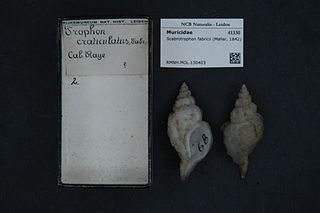
Scabrotrophon is a genus of sea snails, marine gastropod mollusks in the subfamily Trophoninae ( of the family Muricidae, the murex snails or rock snails.

Electromyrmococcus is an extinct genus of mealybug in the Pseudococcidae subfamily Rhizoecinae. The genus currently contains three species, all from the early Miocene, Burdigalian stage, Dominican amber deposits on the island of Hispaniola.

Lasius alienus, or cornfield ant, is a species of ant in the subfamily Formicinae. Workers have a length of about 2–4 mm, Queens are larger (7–9 mm).
Lasius balearicus is an ant species from the genus Lasius. It was discovered in 1982 by Cedric Alex Collingwood, an entomologist from the Royal Entomological Society and described as a new species in 2014 after a team from the Institut de Biologia Evolutiva in Barcelona collected the holotype in 2008. L. balearicus is confined to the island of Majorca and it is the first known endemic ant species from the Balearic Islands and the first known endemic Lasius species from any Mediterranean island.

Lasius neoniger, also known as the turfgrass ant, Labour day ant, cornfield ant or nuisance ant, is a species of ant in the genus Lasius. Found in North America, the species is common in the eastern United States and Canada, though they can be found all over the continent. They are usually light brown in color, with a slightly darker head.

Lasius brunneus is a species of ant in the genus Lasius. The species is widely distributed in Europe, from Sweden in the north to Anatolia in the south. In England this species is almost always found nesting in oak trees or rotting wood mainly foraging in trees but has also been found under stones and foraging on the ground. It is thought to be underrecorded but is fairly common especially in the South East.
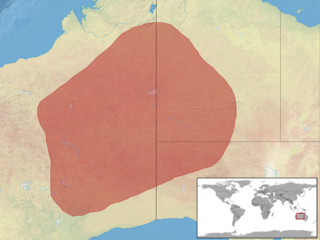
The western soil-crevice skink is a species of skink found in Australia.
Diporiphora reginae, the plain-backed two-line dragon, is a species of agama found in Australia.
















